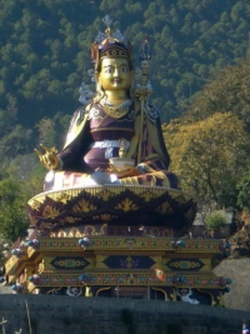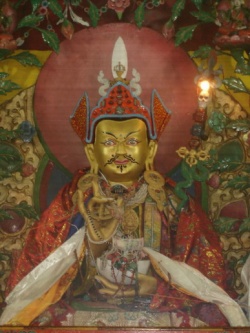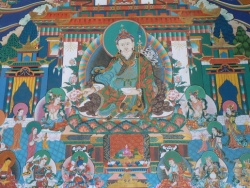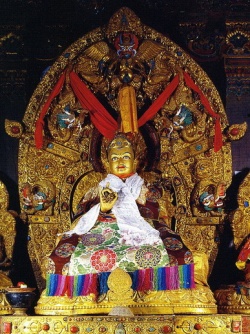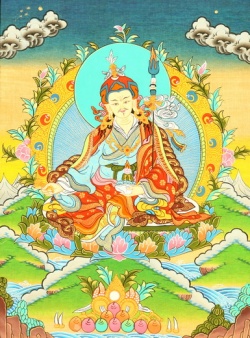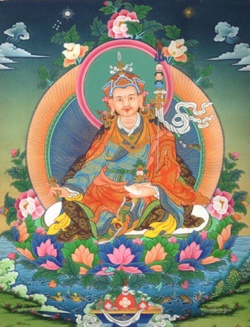Nyingma (Nying-mapa)Tradition
The Nyingma (ancient) school of Tibetan or Vajrayana Buddhism was founded in the eighth century by the great enlightened Indian tantric master Padmasambhava, "the second Buddha," and is the oldest of the four schools of Tibetan Buddhism (Nyingma, Kagyu, Sakya, and Gelugpa).
Its teachings, transmissions and lineage of enlightened masters have continued unbroken to this day. At the heart of the Nyingma tradition is the practice of Dzog Chen, the most ancient and direct stream of wisdom within the teachings of Buddhism.
Mipham Rinpoche (1846-1912), one of Tibet's greatest scholars and masters, wrote: Crowning the banner of the complete teaching of the Buddha, is the beautiful ornament of the clear light teachings of Dzogpa Chenpo. Through practising and realizing these teachings, tens of thousands of beings have become enlightened.
Although the Nyingmapa school is the oldest tradition of Tibetan Buddhism, its Dzog Chen teachings are the clearest, most effective and relevant to the needs of beings today. Untouched by the sometimes tragic events in Tibetan history, the Dzog Chen teachings have been passed down in an unbroken line from the Primordial Buddha Samantabhadra, teacher to student, to this day, in all their freshness, immediacy, and power.
"Dzog Chen is a state, the primordial state, the state of total awakening that is the heart essence of all the Buddhas and all spiritual paths, the summit of an individual beings spiritual evolution."
Dzog Chen can only be understood and fully realized with the direct guidance of a qualified and experienced Dzog Chen master. His Holiness Penor Rinpoche is such a being, an emanation of the great Dzog Chen master Vimalamitra. The Palyul Lineage Mingyur Dorje In Tibet, there were six mother monasteries which upheld the Nyingma tradition. In eastern Tibet, the foremost of these was the glorious Palyul. The land the monastery is situated on was blessed by many great saints and bodhisattvas and it was during the time of the great vidyadhara Kuzang Sherab that the Palyul tradition was established and the monastery known as Palyul Namgyal Changchub Choling became one of the major Nyingma monastic institutions.
As with all Nyingma Dharma lineages, the Palyul holds the complete canon of the Mahayana sutras and tantras as well as the Kama (long), Terma (short) and Pure Vision transmissions. However, the Palyul lineage is distinct in that it continues to practice, realize and transmit all the various lineages and transmissions that were held and passed on by Kunzang Sherab into one vast Dharma Ocean. The Kama or long lineage is the combined oral tradition of Panchen Vimalamitra, the translator Vairocana and master Padmasambhava on the inner yogas of Generation Stage Maha Yoga, Transmission stage Anu Yoga and the Great Perfection stage Ati Yoga.
The Palyul also holds the Non-dual Great Seal Mahamudra - Great Perfection Ati Yoga, uniting the highest Nyingma teachings of Dzog Chen with the ornament of the Kagyu school, the Mahamudra of Marpa the translator, forefather of the Kagyu. From Kunzang Sherab to the present throne holder, His Holiness Penor Rinpoche, as well as the greater Palyul sangha, this has been maintained as a principal practice which includes:
clear light togyal,
inner togyal,
darkness practice,
dream practice,
training in the nature of sound and
pure realms practice.
The terma or short lineage refers to spiritual treasures (terma) that were concealed by Padmasambava and his close disciples to be revealed at a later, more appropriate time. These termas were hidden in both physical elements and within beings mind streams, to be remembered and revealed in later incarnations. As such, the lineage for these termas is considered "short" historically, as opposed to the long lineages originating with Sakyamuni Buddha.
The principal terma lineages of the Palyul are those of Terton Nyang, Guru Chowang, Ratna Lingpa, Jigme Lingpa, Karma Lingpa and Mingyur Dorje. The Profound lineage of Pure Vision originates with Terton Mingyur Dorje's Nam Cho Great Perfection revelations, transmitted directly to Kunzang Sherab.
HOW THE TEACHINGS WERE TRANSMITTED
The teachings of the Nyingma (Old Translation) School are transmitted through two main systems, the kahma and terma lineages. Kahma refers to all the teachings and transmissions passed down through the centuries by the long lineage of teachers and disciples. Terma refers to the previously hidden, rediscovered teachings of the short and direct lineage (nyegyu) from Guru Rinpoche and other enlightened ones. These masters transmit teachings directly through their deathless wisdom-body in visionary experience to the terton who discovers and reveals these teachings.
Such a short, fresh, direct, extremely powerful, and profound transmission is the terma of Jigme Lingpa's Longchen Nyingthig. Of the nine volumes of Jigme Lingpa's writings, two are gong-ter (wisdom-mind treasures).
Jigme Lingpa said that there are four purposes for the discovery of terma:
so the Dharma won't disappear;
so that the essential instructions don't become adulterated over long periods of time when mistakes and breaches of commitments and misunderstanding might take place;
so that the blessings do not fade;
and so that the direct lineage of transmission is maintained.
The terma provide teachings by Guru Rinpoche Padma Sambhava that are appropriate to the various needs and natures of different people in different places and times. One can obtain the ultimate fruit of the path by practicing one particular terma alone, for each is complete in itself; yet in order to preserve and uphold all the teachings of the Buddhadharma in its totality, one must also to receive the kahma lineage transmission. Therefore, the kahma and terma are generally practiced and passed on inseparably.
Dzogchen teachings are generally classified into three main categories:
Sem De (Mind Class),
Long De (Expanse Class),
and Mengak-ki De (Pith-Instructions Class).
This threefold classification was made by Jampel Shenyen, Garab Dorje's disciple.
Twenty-one major tantras form the basis of Sem De.
Nine tantras (divided into groups of three: white, black, and multicolored) form the basis of Long De.
The Mengak-ki De category is subdivided into four subsections. The fourth of these, Gyu Rangshung, is the text of root tantras and explanatory tantras in the most complete essentialized form. These are the pith-instructions proper.
The subsection of Gyu Rangshung in Mengak-ki De is itself divided into four groups known as Thigle Korshi. These four are
Chikor (Outer Cycle),
Nangkor (Inner Cycle),
Sangkor (Secret Cycle), and
Yangsang Lame (Supersecret and Highest).
This fourfold classification was made by Sri Simha, Jampel Shenyen's disciple.
Nyingthig is short for Nying-ki Thigle, meaning Heart-Essence or Innermost Essence. It refers to the most quintessential pith-instructions (mengak) of Ati Dzogpa Chenpo.
The term Nyingthig pertains solely to the Mengak-ki De (pith instructions) group of Dzogchen teachings. Moreover, it often refers in particular to the innermost or most profound and secret core of those pith-instructions, known as Yangsang Lame.
Therefore, these teachings are also known as Sangwa Nyingthig (Secret Heart-Essence), Osel Nyingthig (Luminous Innermost Essence), or Mengak Nyingthig (Heart-Essence of the Pith-Instructions).
Each of these terms refer to the unique Nyingthig teachings found primarily in the Yangsang Lame section of the Mengak-ki De. The seventeen main tantras of Mengak-ki De form the basis for the Yangsang Lame. (According to the tradition of Vimalamitra, there are eighteen tantras; according to Guru Rinpoche's tradition, there are nineteen. These are mostly the same tantras, with very slight variations; both masters received this transmission from Sri Simha.) These tantras are found in the thirty-six-volume collection of Nyingma tantras called Nyingma Gyubum that were compiled by Terchen Ratna Lingpa, the greatest of the thirteen supreme Lingpas (tertons or treasure-masters).
It is difficult for ordinary beings to understand the tantras without the explanations of a qualified teacher. Gyalwa Longchenpa's Seven Treasures (Dzodun) was written in order to elucidate the extraordinarily profound meaning of the seventeen main tantras of Dzogpa Chenpo, as well as the teachings of all nine yanas (vehicles).
For the purpose of the actual practice of Dzogchen according to these tantras, Longchenpa gathered his own termas as well as those of Chetsun Senge Wangchuk (who was later reborn as Jamyang Khyentse Wangpo) and Pema Ladrey Tsel (Longchenpa's previous incarnation) in the form of the thirteen volume collection known as the Nyingthig Yabshi. This Yabshi is the practice aspect of Longchenpa's writings and the basis of the Old Nyingthig. In it he synthesized the Bima Nyingthig of Vimalamitra and the Khandro Nyingthig of Guru Rinpoche and explained all the practical details in the light of his own realization.
The condensed essence of all the tantric teachings elucidated in the Seven Treasures of Longchenpa is contained in Jigme Lingpa's poetic Yonten Dzo, The Treasury of Enlightened Qualities. The practices included in the Nyingthig Yabshi are condensed in a form that is easy to apply in Jigme Lingpa's four-volume Nyingthig Tsapod, which includes the renowned Triyig Yeshe Lama. This core teaching of the Tsapod is the basis of the extraordinary Dzogchen togal practice of the Longchen Nyingthig. These rare and extraordinarily profound teachings precisely explain various essential methods for directly actualizing the innermost teachings of Ati Dzogpa Chenpo, the Great Perfection, the Peak Vehicle, which is the direct method for swiftly realizing the ultimate nature of the mind and attaining Buddhahood in the Rainbow Light Body. In modern times the Longchen Nyingthig is the main practice at the center of all these Dzogchen teachings and pith-instructions.
